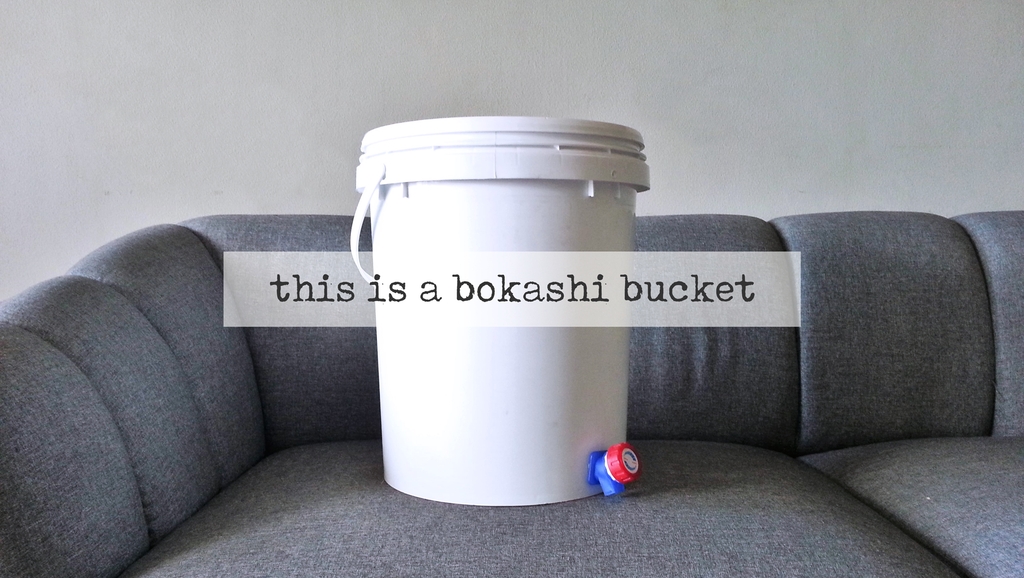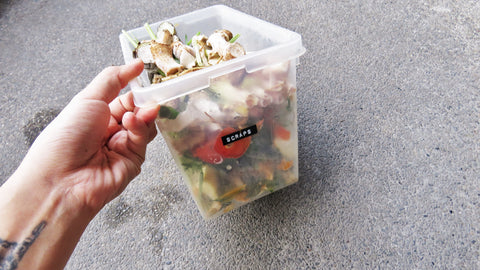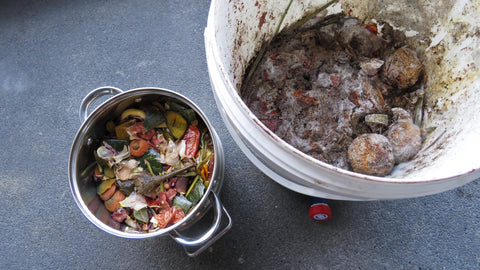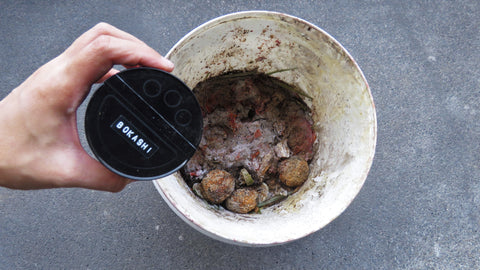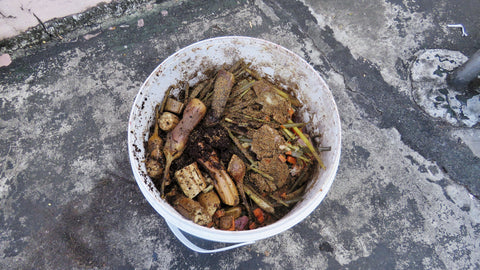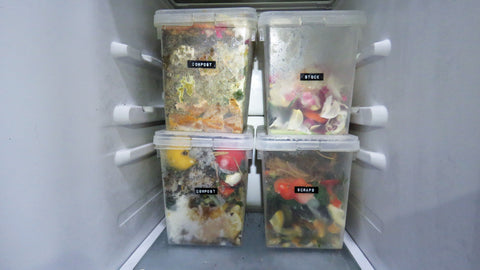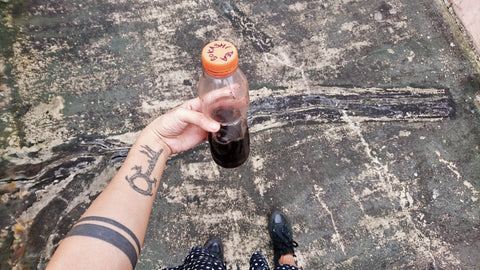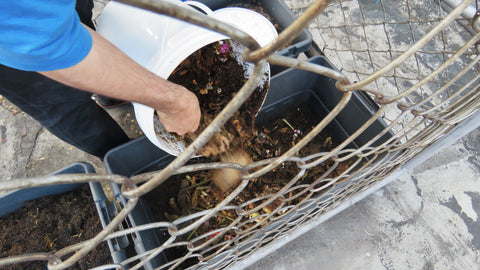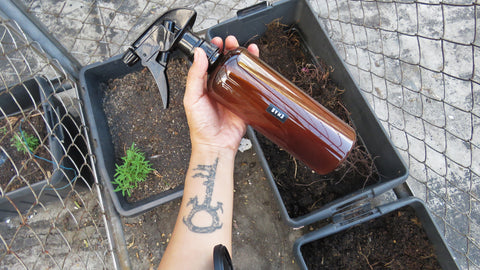What do you do with your kitchen waste?
Food waste is one of the largest drivers of the planet's climate crisis. Most people just send their food waste to landfills and think that there's nothing wrong with that, since food is biodegradable anyway. Thing is, when not properly managed/composted, food waste dumps large amounts of potent greenhouse gases into the environment. When we compost our food scraps properly, (instead of sending them to landfills,) we not only minimize the release of methane from our waste into the environment— we also put nutrients back into our soil.
Going zero-waste is a lot more challenging when you live in a concrete jungle. Traditional composting methods aren't always easy to do in the urban setting because they usually require space, ventilation, and anosmic neighbors. My fiance/zombie-apocalypse partner and I live in a building, so I'd like to share what we do with our organic/biodegradable/kitchen waste, with anyone out there who might be struggling with theirs: We turn our kitchen waste into beautiful compost with Bokashi.
What is Bokashi?
Bokashi (ぼかし) is Japanese for "shading off" or "gradation."
Bokashi is an anaerobic process that uses microorganisms to ferment organic matter in an acidic environment, breaking it down faster than traditional composting processes. Bokashi is often called a "composting process." Technically though, Bokashi is a fermentation process— not a traditional composting process.
How does it work?
Lactic acid bacteria (Lactobacillus spp.), yeasts (Saccharomyces spp.), photosynthetic bacteria (Rhodopseudomonas spp.), actinomycetes, and fungi are introduced to organic matter in an airtight container via an inoculated carbon source. The anaerobic microorganisms from the inoculated carbon source consume the sugars in the organic waste, fermenting it. The resulting Bokashi ferment is composted, and assimilated into soil at an accelerated rate.
Still confused? Here's the non-nerdy version:
So normally, when you dispose of food waste, what happens is that "bad bacteria" get access to the stuff and consume it. Then it rots, and it stinks, and it smells like death.
With Bokashi however, what you do is put your food waste in a controlled environment (i.e. an airtight bucket), and introduce some "good bacteria" to it. The good bacteria then duke it out with whatever bad bacteria are around, and break the waste down. So instead of rotting and stinking, your food waste ferments and smells like vinegar. Essentially, you are pickling your trash. Think atsara!
Once you've got your pickled food waste, you dump everything into a container of soil, and everything turns into a dark, rich, loam soil in a matter of weeks.
Why do Bokashi over traditional composting?
- The entire process can be done purely indoors.
- Insects, rodents, and other vermin are not an issue.
- Organic waste does not have to be turned on a regular basis.
- Greens and browns don't have to be mixed in a specific ratio.
- All types of food waste can be processed, including meat, fish, dairy, and bread.
- There are no putrid odours.
- Minimal greenhouse gasses are produced.
- No nutrients are lost to the ground or atmosphere.
- Organic waste is processed and assimilated into soil at a much faster rate— weeks, instead of months.
- The end-product is not only nutrient-rich, but also full of beneficial microorganisms.
What do you need in order to get started?
-
Bokashi bucket
A food-grade, airtight, fermentation bucket, with a spigot for draining liquids
-
Bokashi bran
Rice bran inoculated with effective microorganisms "good bacteria"
-
Organic waste
Chopped up kitchen scraps, food waste, garden trimmings, paper
-
Soil
If you do not have a backyard, you can simply put soil in a large plastic bin (with holes) which will serve as your "soil factory"
Where do you get Bokashi buckets/bran in the Philippines?
Bokashi products are available on our website:
- Bokashi bucket + bran fermentation kits
- Bokashi bran by the kilo
-
Effective Microorganisms Activated Solution (EMAS) Kit (Optional but good to have)
We also carry them whenever we participate at bazaars or do talks/workshops. Subscribe to our Facebook Page Druid Things by clicking "follow" and "see first" to get updates on where we'll be popping up next.
See our lineup of events here:
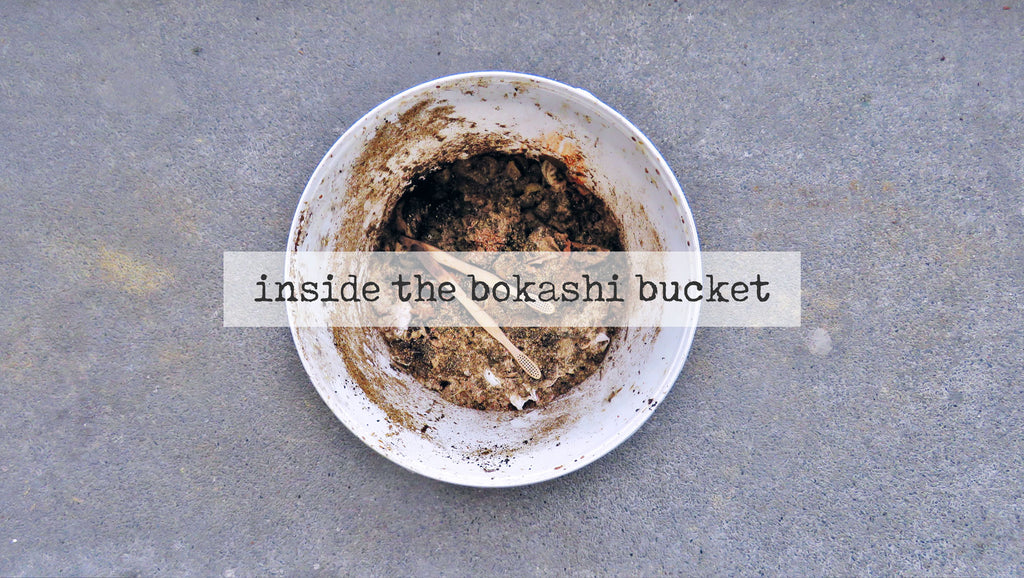
How do you process kitchen waste with Bokashi?
Processing your food waste with Bokashi is actually very easy to do. This article just looks long because we try to explain and flesh each step out as best as we can. Here's a very detailed step by step guide to fermenting and composting your food waste using Bokashi:
1. Mix a handful of Bokashi bran into chopped up food waste
Chop kitchen waste into small pieces. Add 1 handful of Bokashi bran. Mix well. (What's a handful? About 2 tablespoons of Bokashi bran per kilo of food waste.)
Chopping up your kitchen waste into smaller particles will ensure that the bacteria will have more surface area to latch on to and digest. Make sure you mix everything well and spread the bran evenly. Use more bran for any high-protein foods such as meat, fish, and dairy.
Note:
Although you can technically process meat, fish, and dairy scraps in a Bokashi bucket, we advise avoiding/minimizing it, especially if you plan on using your compost to grow edible plants. (Think about it—would you eat carrots and tomatoes grown in soil where dead bodies are buried? You can, but would you, if you had a choice?) Meat waste usually carries and attracts a host of different pathogens and bacteria from plant waste. That's why herbivore poop, not carnivore poop, is what's used as organic fertilizer for crops.
The chances of spoiling your bucket are also higher the more meat, dairy, and oils you have in it. You will also need to compost your food waste for longer, especially if there are bones and/or shells in the mix.
If you are going to include meat, try to shred/cut the waste into smaller pieces. If you are going to include bones or shells, try to break them into smaller shards.
(Side note: Animal agriculture is also one of the largest drivers of climate change. Cutting meat out of one's diet is one of the most impactful things anyone can do to fight the planet's climate crisis.)
2. Layer your food waste into the bucket and press down on it
Always add a light sprinkling of Bokashi bran into the your bucket before and after adding in any kitchen waste. This ensures that you have the microbes over, under, and all around your kitchen scraps.
Anaerobic bacteria thrive in dark, airless environments. Compressing your food waste helps eliminate any pockets of air from the food waste and encourage more bacterial growth.
Press down on your kitchen waste every time you add a new layer and always cover the bucket tightly.
Tip:
You can use a potato masher, a plate, a pot cover, or even your bare hands (if you aren't the squeamish type) to press down on the waste.
3. Seal and store your Bokashi bucket properly
For fermentation to happen, the Bokashi bucket must always be completely sealed. (Make sure that it clicks shut.) You can minimize the number of times you open your bucket by first collecting your food waste in a smaller covered container, or by keeping your food waste in the freezer. Refrain from opening the bucket more than once a day— it would be better to open the bucket once every few days, or even just once a week.
Always keep the bucket in a shaded area. (We keep ours under our kitchen sink.) The contents of the bucket may get warm and sweat. Keeping the bucket in a shaded area will ensure that the bucket does not get too "hot" and kill the microbes off.
The contents of the bucket should have a sweet-sour smell. Think, rice-wine. Or apple-cider vinegar. You are pickling your trash, so it should smell somewhat acidic. If the contents of your Bokashi bucket start to smell funky, add more bran. You don't have enough good bacteria processing your trash.
Over time, you may see white mould form within the bucket. That's totally okay. If the mould is black/green/blue and the contents of the bucket smell terribly putrid though, that means the waste is putrefying instead of fermenting, and you must start over. (This may happen if the bucket is not completely sealed.)
Note:
Avoid leaving kitchen scraps exposed to open air, as flies may lay eggs in your food scraps. The quantity of aerobic "bad" bacteria also increases the longer you have your food waste exposed, which means the anaerobic "good" bacteria will need to fight harder for the waste to properly ferment. If you are unable to process your kitchen scraps as soon as they are produced, you can keep them in a smaller container, or freeze them first.
Zero-waste Tip:
We collect vegetable scraps in our freezer and make vegetable stock with them first, before mixing some bran in and dumping everything into our Bokashi bucket.
4. Regularly collect Bokashi "tea" from your Bokashi bucket
Drain the bucket of any liquids once every few days, (or once a week,) using the bucket's tap. The Bokashi "tea" or "juice" you collect can be diluted in water and used in the garden.
Tip:
We just collect Bokashi tea whenever we add a new layer of food waste. No need to fuss over this step too much.
Using Bokashi tea in the garden:
Bokashi tea is concentrated with nutrients and microorganisms beneficial to plants. It is highly acidic and must be diluted with water at a 1:100 ratio. (Approximately 2 teaspoons of Bokashi tea for every 1L of water.) This cocktail is best used as a soil drench for plants. Do not apply directly to foliage.
Using Bokashi tea to clear drains:
Pour concentrated Bokashi tea into kitchen drains, bathroom drains, toilets, and septic systems. The microorganisms prevent algae build-up, and help with odour-control.
5. Let your food waste ferment for two weeks
Once the bucket is full, seal and store the bucket in a shaded area for at least 14 days.
Having two Bokashi buckets will allow you to continue processing your kitchen waste in one bucket while the other is kept airtight to ferment for two weeks. Having only one bucket is sufficient if you produce minimal food waste, and/or if you collect your kitchen scraps in a freezer.
Note:
Your Bokashi scraps will not turn into soil after this step. Your food waste will simply ferment and break down chemically, but will still somewhat look the same. Your apple slices will still look like apple slices. Orange rind will still look like orange rind. You will still need to compost your Bokashi ferment in order for the stuff to biodegrade completely.
6. Compost your Bokashi ferment
After fermenting the waste for 14 days, mix 1 part of fermented kitchen waste to 3 parts of soil. (OPTIONAL: You can dilute 20ml of EMAS* to 1L of water and spray the mixture with it. This will help speed up decomposition.)
You can dig a pit/trench in the ground and dump all of the contents of the bucket in there. Animals and insects generally stay away from Bokashi ferment as it is highly acidic, so you won't really have a problem with cats, rats, roaches, and the like. Cover the pit completely with soil, et voila! You are done. For established gardens, dig your trenches around trees or between plants. Bokashi ferment can also be added to a conventional compost bin.
If you do not have a backyard or a compost bin, you can create your own "soil factory" using one or two large plastic bins with soil (see above photos). These plastic bins must not be airtight and must not be placed under direct sunlight. Drill holes into these plastic bins. This phase is no longer anaerobic, so you want oxygen to get in. This is when your "ferment" actually turns into "compost."
Note:
Bokashi ferment is acidic when first dug in. Roots of young plants /seedlings must not come into contact with the mixture during this time. Leave the Bokashi waste for 2 to 3 weeks to fully decompose, (so the acids are neutralized,) before sowing or transplanting. Once the waste has been completely broken down, the compost can be used as a rich top-soil and/or soil amendment.
*Effective Microorganisms Activated Solution (EMAS) is "liquid Bokashi" made by mixing a solution of EM-1 culture, molasses, and dechlorinated water or "hugas bigas."
EM-1 mother culture and molasses kits are available on our website. Information on the many applications of EMAS can also be found on the How-To tab of this page:
Effective Microorganisms Activated Solution (EMAS) Kit
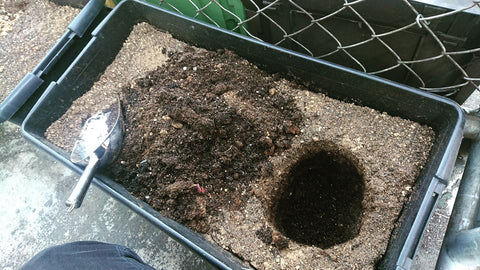


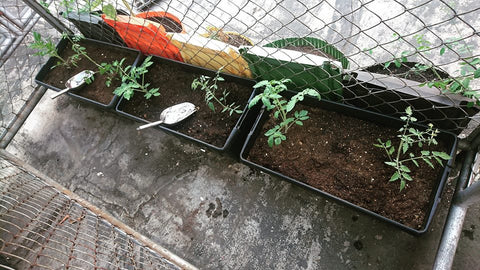
✚

